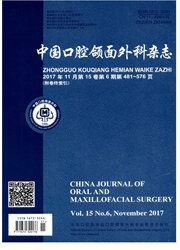

 中文摘要:
中文摘要:
目的:回顾分析颅颌面部骨折引起外耳道出血的原因和比例。方法:回顾上海交通大学医学院附属第九人民医院VI腔外科及神经外科2006年4月-2011年12月收治的颅颌面部骨折病例,按照颅底骨折、面中部骨折和下颌骨骨折进行分类,统计外耳道出血的发生率.并通过CT分析其原因。应用SAS6.0软件包对数据进行统计学分析。结果:573例颅颌面骨折中,外耳道出血43例53侧,其中19侧由单纯颅底骨折引起,占35.8%;26侧由下颌骨髁突骨折引起,占49.1%(92.3%为囊内骨折引起);无髁突骨折的下颌骨骨折7侧,占13.2%;单纯面中部骨折1侧,占1.9%。除颅底骨折外,其余颌面部骨折引起外耳道出血的原因均是外耳道前壁骨折。结论:颅颌面部骨折引起外耳道出血的原因中.髁突骨折占首位,以囊内骨折为主。
 英文摘要:
英文摘要:
PURPOSE: To analyze the incidence and reason of external auditory canal bleeding (EACB) caused by craniofacial fractures. METHODS: Craniofacial fractures treated in the Departments of Oral Surgery and Neurosurgery of Shanghai Ninth People's Hospital from April 2006 to December 2011 were retrospectively studied and divided into 4 groups: skull base fracture alone, mid-facial fracture and mandibular fracture with and without condylar fractures. The incidence of EACB in EACB group was recorded. Computed tomography (CT) scan was analyzed for EACB reasons. SAS 6.0 software package was used for statistical analysis. RESULTS: Five hundred and seventy-three cases were involved in the study. EACB was found in 43 cases. Among them, skull base fracture accounted for 35.8%, mandibular condyle fracture accounted for 49.1% (92.3% was intracapsular condylar fractures), non-mandibular condylar fracture accounted for 13.2% and mid-facial fracture accounted for 1.9%. Except for skull base fractures, EACB caused by facial fractures was all due to EAC anterior wall fractures. CONCLUSION: Mandibular intracapsular condyle fracture is the main reason for EACB in craniofacial fractures. Supported by Research Fund of Science and Technology Commission of Shanghai Municipality (08DZ2271100), Program for Innovative Research Team of Shanghai Municipal Education Commission; Health and Welfare Industry, Research and Special Project Funding (201002017); Scientific Research Foundation for Returned Overseas Chinese Scholars, Ministry of Education of China.
 同期刊论文项目
同期刊论文项目
 同项目期刊论文
同项目期刊论文
 期刊信息
期刊信息
